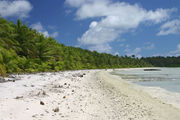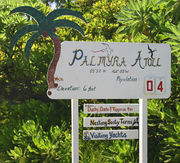Palmyra Atoll
.jpg)


Palmyra Atoll (pronounced /pælˈmaɪrə/) is an incorporated atoll administered by the United States federal government. The atoll is 4.6 sq mi (12 km2), and it is located in the Northern Pacific Ocean. Geographically, Palmyra is one of the Northern Line Islands (southeast of Kingman Reef and north of Kiribati Line Islands), located almost due south of the Hawaiian Islands, roughly halfway between Hawaii and American Samoa. Its 9 mi (14 km) of coastline has one anchorage known as West Lagoon. It consists of an extensive reef, two shallow lagoons, and some 50 sand and reef-rock islets and bars covered with vegetation—mostly coconut trees, Scaevola, and tall Pisonia trees.
The islets of the atoll are all connected, except Sand Island and the two Home Islets in the west and Barren Island in the east. The largest island is Cooper Island in the north, followed by Kaula Island in the south. The northern arch of islets is formed by Strawn Island, Cooper Island, Aviation Island, Quail Island, Whippoorwill Island, followed in the east by Eastern Island, Papala Island, and Pelican Island, and in the south by Bird Island, Holei Island, Engineer Island, Tanager Island, Marine Island, Kaula Island, Paradise Island, and Home Island (clockwise). Average annual rainfall is approximately 175 in (4,400 mm) per year. Daytime temperatures average 85°F (29°C) year round.
Contents |
Political status
Palmyra is an incorporated territory of the United States (the only such territory since 1959), meaning that it is subject to all provisions contained in the United States Constitution and is permanently under U.S. sovereignty. However, it is also an unorganized territory as there is no Congressional act specifying how it should be governed; the only relevant law simply gives the President the discretion to administer the island as best seen fit (see Section 48 of the Hawaii Omnibus Act, Pub. L. 86–624, July 12, 1960, 74 Stat. 411, attached as a note to former sections 491 to 636 of Title 48, United States Code [1]).

The issue of Palmyra’s governance is generally a moot point, as there is no indigenous population remaining nor any reason to think that there will be one in the future. It remains therefore currently the only unorganized incorporated U.S. territory. Cooper Island is privately owned by The Nature Conservancy and managed as a nature reserve; the rest of the atoll is government land in the possession of the United States Fish and Wildlife Service.[2] Since the territory has no local government, it is administered directly from Washington, D.C., by the Office of Insular Affairs, United States Department of the Interior. Defense is the responsibility of the United States.
For statistical purposes, Palmyra is grouped as one of the United States Minor Outlying Islands.

There is no current economic activity on the island. Many of the roads and causeways on the atoll were built during World War II. All are now unserviceable and overgrown. There is a roughly 2,200 yard (2,000 m) long, unpaved and unimproved airstrip on Cooper Island (Palmyra Airport, ICAO code PLPA). Various abandoned World War II–era structures are found on the island.
The atoll has been manned by a group of scientists, Nature Conservancy staff and volunteers, and Fish & Wildlife representatives (totaling between four and 20 in all) for the last several years. A series of improvements in 2004 consisted of new two-person bungalows and showers for the island's inhabitants. Water is collected from the roof of a concrete building not far from the main living area of the scientists. Communal buildings of the settlement on the north side of Cooper Island (the only one on the atoll) consist of a common cooking/dining building adjacent to the atoll's only dock and a kayak and scuba equipment storage building next to the launch ramp.
Palmyra Atoll's location in the Pacific Ocean, where the southern and northern currents meet, means that its beaches are littered with trash and debris. Plastic mooring buoys are particularly plentiful on the beaches of Palmyra, as well as plastic bottles for soft drinks, detergents, etc.
Large parts of the atoll are closed to any sort of public access due to the threat of uncleared World War II unexploded ordnance.
History

Palmyra was first sighted in 1798 by an American sea captain, Edmund Fanning of Stonington, Connecticut, while his ship the Betsy was in transit to Asia. On November 7, 1802 the first Western people landed when the United States ship Palmyra was wrecked on the atoll.
In 1859, Palmyra was claimed by Dr. Gerrit P. Judd for the United States, under the Guano Islands Act of 1856; however, there was no guano to be mined. Meanwhile, on February 26, 1862, Kamehameha IV (1834–1863), Fourth King of Hawaii (1854–1863), issued a commission to take possession of the atoll and on April 15, 1862, it was formally annexed to the Kingdom of Hawaii.[3]
In 1898, Palmyra was annexed to the U.S. in conjunction with the overall U.S. annexation of Hawaii; on June 14, 1900, it became part of the then U.S. Territory of Hawaii. In the period preceding the formal annexation of the atoll by the U.S., the United Kingdom had shown interest for the atoll to become part of the “Guano Empire” of John T. Arundel & Co; and in 1889 the British had even formally annexed it. In order to end all further British attempts or contestations, a second, separate act of annexation of Palmyra by the U.S. was made in 1911.
By a series of transactions, Henry Ernest Cooper (1857–1929) became the sole owner of the atoll. On February 21, 1912, it was formally claimed by the U.S. government, still as part of Hawaii Territory.
In 1922, Cooper sold most of atoll to Leslie and Ellen Fullard-Leo, parents of actor Leslie Vincent, on August 19, 1922. They established the Palmyra Copra Company to exploit the coconuts growing on the atoll. Their heirs continued as proprietors except for Navy administration during World War II.
In 1934, Johnston Atoll, Kingman Reef, and Palmyra were placed under the Department of the Navy. The U.S. Navy took over the atoll for use as the Palmyra Island Naval Air Station on August 15, 1941. From November 1939 to 1947, the atoll had only permanently resident government representatives, styled “island commanders.”
After the war, the Fullard-Leo family fought for the return of Palmyra all the way to the U.S. Supreme Court and won in 1947. When Hawaii achieved statehood in 1959, Palmyra was explicitly separated from the new state as an incorporated territory of the U.S., administered by the U.S. Department of the Interior.[3] In 1962, the U.S. Department of Defense used the atoll for an instrumentation site during high altitude atomic weapon tests over Johnston Island.
In December 2000, most of the atoll was purchased by The Nature Conservancy,[3] for the purposes of coral reef conservation and research. The Cooper family still owns two of the five Home Islands.[3] In 2003, a scientific study was published regarding fossil coral washed up on Palmyra Atoll. The fossil coral was examined for evidence of the behavior of the El Niño effect on the tropical Pacific over the past 1,000 years.[4] In November 2005, a worldwide team of scientists joined with The Nature Conservancy to launch a new research station on the Palmyra Atoll in order to study global warming, disappearing coral reefs, invasive species and other global environmental threats.
The Pacific Remote Islands Marine National Monument established on January 6, 2009 included Palmyra Atoll. The Secretary of the Interior has management responsibility, delegated to the Fish and Wildlife Service.[5]
On January 18, 2001, the Secretary of the Interior signed an order designating Palmyra’s tidal lands, submerged lands, and surrounding waters out to 12 nautical miles from the water’s edge as a National Wildlife Refuge. Subsequently, the Department of the Interior published a regulation providing for the management of the refuge. 66 Fed. Reg. 7660-01 (Jan. 24, 2001). The regulation states, in pertinent part, as follows:
"We will close the refuge to commercial fishing but will permit a low level of compatible recreational fishing for bonefishing and deep water sportfishing under programs that we will carefully manage to ensure compatibility with refuge purposes. . . . Management actions will include protection of the refuge waters and wildlife from commercial fishing activities."
In March 2003, The Nature Conservancy conveyed 416 acres of the emergent land of Palmyra to the United States to be included in the refuge. It subsequently added 28 more acres to the conveyance.
In January 2007, several parties sued the United States in the Court of Federal Claims alleging that, under the Takings Clause, the Interior Department regulation had “directly confiscated, taken, and rendered wholly and completely worthless” their purported property interests. The United States filed a motion to dismiss the lawsuit, and the court granted the motion.[6] On April 9, 2009, the court's decision was affirmed by the Court of Appeals for the Federal Circuit.[7]
As of July 2009, limited visits to the refuge are allowed for certain circumstances, including by private recreational sailboat or motorboat. Such visits must have prior approval, with access to Cooper Island arranged through The Nature Conservancy.[8]
The Sea Wind murders
In 1974, Palmyra was the site of the notable double murder of a wealthy San Diego couple, Malcolm "Mac" Graham and his wife, Eleanor "Muff" Graham.[9] The mysterious deaths and murder conviction of Duane (“Buck”) Walker (later known as Wesley G. Walker) made headlines nationwide and led to a best-selling account co-written by one of Walker's attorneys, Vincent Bugliosi, in the true crime book And the Sea Will Tell. It also sparked a TV miniseries by the same name starring James Brolin and Rachel Ward.
Walker and his girlfriend, Stephanie Stearns, were arrested in Honolulu in 1974 after returning from Palmyra aboard a yacht stolen from the Grahams. Because no bodies were found at the time, Walker and Stearns were initially prosecuted only for the yacht theft and convicted in August 1975. Six years later, a corroded chest was found partially buried in a lagoon at Palmyra. Inside were Eleanor Graham's remains, identified with dental records. Walker and Stearns were arrested in Arizona for murder. Walker was convicted in 1985, and Stearns was acquitted. He served 22 years before receiving early parole in 2007 from the United States Penitentiary, Victorville, California. Walker died on April 26, 2010.
See also
- List of Guano Island claims
References
- ↑ Title 48 Chapter 3. US Code Collection. Cornell Law School. URL retrieved February 10, 2007.
- ↑ http://www.honoluluadvertiser.com/article/20090107/NEWS11/901070367/-1/localnewsfront
- ↑ 3.0 3.1 3.2 3.3 "Palmyra Atoll". US Department of the Interior Office of Insular Affairs. http://www.doi.gov/oia/Islandpages/palmyrapage.htm. Retrieved 2008-01-06.
- ↑ K. M. Cobb et al., El Niño/Southern Oscillation and Tropic Pacific Climate During the Last Millennium, Nature, Vol. 424, 17 July 2003
- ↑ "Pacific Remote Islands Marine National Monument". fws.gov. U.S. Fish and Wildlife Service. http://www.fws.gov/pacificremoteislandsmarinemonument/. Retrieved 2009-07-31.
- ↑ Palmyra Pac. Seafoods, L.L.C. v. United States, 80 Fed. Cl. 228 .
- ↑ Palmyra Pacific Seafoods v. U.S., 561 F.3d 1361 .
- ↑ "Visiting Palmyra Atoll National Wildlife Refuge". fws.gov. U.S. Fish and Wildlife Service. http://www.fws.gov/palmyraatoll/visit.html. Retrieved 2009-07-31.
- ↑ Mary Vorsino (June 2, 2010). "'Buck' Walker infamous for high-profile Palmyra deaths". HonoluluAdvertiser.com. http://www.honoluluadvertiser.com/article/20100602/OBITS01/6020337/-Buck-Walker-infamous-for-high-profile-Palmyra-deaths.
- Rowlett, Curt (2006). Labyrinth13: True Tales of the Occult, Crime & Conspiracy, Chapter 6, The Curse of Palmyra Island. Lulu Press. ISBN 1-4116-6083-8.
External links
- Palmyra atoll
- Palmyra Island
- Palmyra Atoll NWR
- The Curse of Palmyra Island - article
- The Curse of Palmyra Island - book
- The Nature Conservancy in Palmyra Atoll
- Palmyra Atoll Research Consortium
- United States v. Fullard-Leo (Supreme Court opinion; includes a history of the island's ownership)
- WorldStatesmen- U.S.
- History of Palmyra Atoll
- The Palmyra Gazette
|
|||||||||||||||||||||||||||||||
|
||||||||||||||